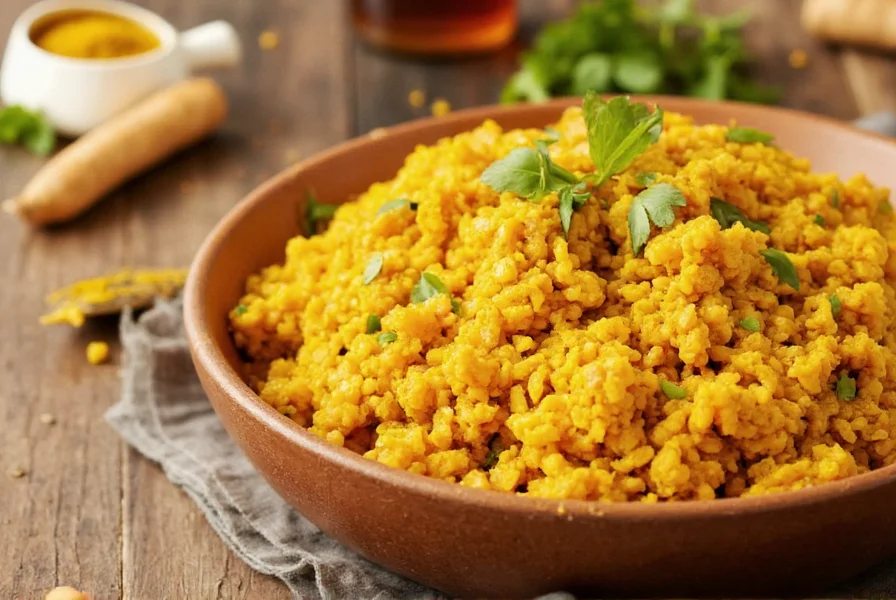Known as the golden spice, turmeric has been transforming kitchens worldwide with its vibrant color and impressive health properties. This ancient ingredient, central to many traditional cuisines, offers more than just visual appeal—it brings depth of flavor and potential wellness benefits to everyday cooking. Understanding how to incorporate turmeric effectively can elevate your culinary repertoire while supporting a healthy lifestyle.
The Culinary Power of Turmeric
Turmeric, derived from the Curcuma longa plant's rhizome, has been used in cooking for thousands of years, particularly in South Asian and Middle Eastern cuisines. Its active compound, curcumin, gives turmeric its distinctive yellow-orange hue and has been studied for potential anti-inflammatory properties. When cooking with turmeric, it's important to understand that fresh turmeric root offers a brighter, more complex flavor profile compared to ground turmeric, though both forms have their place in the kitchen.
Top Turmeric Dishes by Culinary Tradition
Different cultures have perfected unique ways to incorporate turmeric into their signature dishes. Understanding these traditional applications provides valuable insight for home cooks looking to expand their turmeric repertoire.
| Cuisine | Signature Turmeric Dishes | Key Flavor Pairings |
|---|---|---|
| Indian | Golden milk, turmeric chicken curry, dal tadka | Ginger, cumin, coriander, black pepper |
| Middle Eastern | Turmeric rice, lentil soups, spice blends | Cinnamon, cardamom, garlic, lemon |
| Southeast Asian | Thai turmeric soup, Indonesian rice dishes | Lemongrass, galangal, kaffir lime, coconut milk |
| Western Adaptations | Turmeric roasted vegetables, golden lattes, salad dressings | Black pepper, olive oil, citrus, herbs |
Mastering Turmeric in Your Kitchen
Successfully incorporating turmeric into your cooking requires understanding its flavor profile and how it interacts with other ingredients. Turmeric has an earthy, slightly bitter taste with subtle notes of orange and ginger. When using turmeric in dishes, consider these professional cooking techniques:
- Activate curcumin: Always combine turmeric with black pepper and a healthy fat like coconut oil or olive oil to enhance absorption of curcumin
- Temperature control: Add turmeric early in the cooking process for deeper flavor integration, but avoid prolonged high-heat cooking which can diminish its benefits
- Stain management: Use glass or stainless steel containers when preparing turmeric dishes to prevent stubborn yellow stains
- Balance bitterness: Counter turmeric's natural bitterness with citrus, honey, or coconut milk for more complex flavor profiles
Easy Turmeric Recipes for Everyday Cooking
For those new to cooking with turmeric, starting with simple preparations helps build confidence. One of the most accessible turmeric dishes is golden milk—a comforting beverage that combines turmeric with warm milk, black pepper, and optional sweeteners. Another beginner-friendly option is turmeric rice, which transforms ordinary rice into a vibrant, flavorful side dish with just a teaspoon of ground turmeric and complementary spices.
For more substantial meals, turmeric chicken curry offers an excellent introduction to Indian-inspired cooking. This dish typically features chicken simmered in a tomato-based sauce with turmeric, ginger, garlic, and other aromatic spices. The key to perfect turmeric chicken is blooming the spices in oil before adding other ingredients, which maximizes flavor extraction and creates a more complex taste profile.

Avoiding Common Turmeric Cooking Mistakes
Many home cooks encounter challenges when first working with turmeric. The most frequent issue is overusing the spice, which can result in an unpleasantly bitter taste and intense yellow staining. A general rule is that 1/2 to 1 teaspoon of ground turmeric is sufficient for most four-serving dishes. Another common mistake is adding turmeric too late in the cooking process, preventing proper flavor integration.
When working with fresh turmeric root, proper preparation is essential. Peel the skin with a spoon (which works better than a vegetable peeler), then grate or thinly slice the root. Fresh turmeric offers a brighter, more complex flavor but requires careful handling to avoid staining surfaces and clothing. Always wash hands thoroughly after handling fresh turmeric, and consider wearing an apron during preparation.
Storing and Selecting Quality Turmeric
Proper storage maintains turmeric's potency and flavor. Ground turmeric should be kept in an airtight container away from light and heat, ideally using it within six months for optimal flavor. Fresh turmeric root can be stored in the refrigerator for up to three weeks when wrapped in a paper towel and placed in a sealed container.
When selecting turmeric, look for vibrant orange-yellow color in both fresh and ground forms. Dull or faded turmeric indicates age and diminished potency. For fresh turmeric, choose firm, smooth roots without soft spots or mold. High-quality turmeric should have a distinct earthy aroma with citrus notes when fresh, or a warm, spicy scent when ground.

Creating Balanced Turmeric Flavor Profiles
The art of cooking with turmeric involves balancing its distinctive flavor with complementary ingredients. Turmeric pairs exceptionally well with citrus elements like lemon or orange zest, which help counteract its natural bitterness. Coconut milk creates a creamy base that harmonizes with turmeric's earthiness while enhancing curcumin absorption. For savory dishes, combining turmeric with ginger creates a powerful flavor foundation found in many traditional recipes.
When developing your own turmeric dishes, consider the dish's overall flavor architecture. Turmeric works particularly well in dishes with multiple flavor dimensions—such as those incorporating sweet, sour, salty, and umami elements. This complexity helps integrate turmeric's distinctive flavor rather than allowing it to dominate the dish. For example, a well-balanced turmeric lentil soup might include tomatoes for acidity, coconut milk for richness, and a touch of maple syrup to round out the flavors.
Frequently Asked Questions
What are the best turmeric dishes for beginners to try?
Golden milk and turmeric rice are excellent starting points for beginners. Golden milk requires minimal ingredients (turmeric, milk, black pepper, and optional sweetener) and demonstrates turmeric's versatility in beverages. Turmeric rice transforms ordinary rice into a flavorful side dish with just a teaspoon of turmeric and complementary spices like cumin and cardamom, making it perfect for those new to cooking with this spice.
How can I prevent turmeric from staining my kitchen surfaces?
To prevent staining, use glass or stainless steel containers when preparing turmeric dishes, avoid plastic which absorbs color, and clean surfaces immediately after use with a mixture of baking soda and vinegar. When working with fresh turmeric, wear an apron and wash hands thoroughly with lemon juice or a specialized turmeric remover. Adding turmeric to oil first before other ingredients can also reduce its staining potential.
What's the difference between using fresh turmeric and ground turmeric in dishes?
Fresh turmeric offers a brighter, more complex flavor with citrus and ginger notes, while ground turmeric provides a more concentrated earthy flavor. Fresh turmeric should be used within three weeks when stored properly, while ground turmeric maintains potency for about six months. Generally, 1 inch of fresh turmeric equals about 1 teaspoon of ground turmeric, though flavor intensity varies. Fresh turmeric works well in raw applications like juices, while ground turmeric is better for cooked dishes.
Which traditional Indian turmeric dishes are most accessible for home cooking?
Turmeric chicken curry and dal tadka (lentil preparation) are among the most approachable traditional Indian turmeric dishes. These recipes typically use readily available ingredients and straightforward techniques. The key is blooming the turmeric and other spices in oil before adding liquids, which maximizes flavor extraction. Many authentic recipes call for relatively small amounts of turmeric (1/2-1 teaspoon per serving), allowing the spice to enhance rather than dominate the dish.











 浙公网安备
33010002000092号
浙公网安备
33010002000092号 浙B2-20120091-4
浙B2-20120091-4